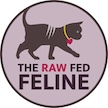Now I am going to move up the pyramid to the secreting organs. Organs are classified as either muscular, which I wrote about here, or secreting. Secreting organs are just that—organs that secrete substances in the body. These organs include the liver, kidney, pancreas, spleen, ovaries, testes, brain, and thymus. Most secreting organs are incredibly nutrient dense and provide many essential vitamins and minerals in the diet. Let’s take a look at each one and how much to feed when feeding a prey model raw rotational diet.
Liver
Liver is the most essential secreting organ to feed. It is not optional like other secreting organs. Liver is a rich source of the essential fat soluble vitamin A. Liver also supplies some B vitamins, iron, and copper. Not all livers have the same nutritional profile, however, so feeding livers from a variety of animals is strongly encouraged. The ratio to feed liver has changed in recent years. It used to vary from 5-10%, but now it is suggested to feed livers from ruminant animals and duck in the range of 2-3%. Duck liver is especially high in vitamin A. Livers from other animals, such as chicken, turkey, and rabbit should be fed at 5%.
There are some important nutrient differences to note about liver, which I am sharing, not to confuse or complicate, but to further support the recommendation to feed a variety. Beef liver is higher in copper than other livers, pork liver does not have any bioavailable copper, duck liver is really high in vitamin A, etc. Truly the best practice is to feed livers from different animals in your cat’s rotation if possible. Chicken and beef livers tend to be the easiest to source for most people.


Other secreting organs
Other secreting organs are fed around 5-8% of the diet. If you can feed more than just one, that is fantastic as each provides nutrients and if a cat was eating whole prey, they would get all of the organs and glands every time.
Kidney is a secreting organ that tends to be a bit easier to source and is nutrient dense. I can always find kidneys at my local Asian market. Kidneys are a great source of B vitamins and selenium. If you can only feed one secreting organ other than liver, kidney is the one to use.
Pancreas is another nice option. It provides important enzymes in the diet.
Spleen is a great organ to include for iron. Cats have a high need for iron in their diet, so being able to provide spleen in the rotation is a great option. Spleen can be tricky to source though. It can often be found in Asian markets or alternatively, you can use a freeze dried product and rehydrate. I have a link to freeze dried spleen here.
Ovaries and testes can also be fed. Testes are a nice source of B12. These are both more difficult to source organs. Sometimes online raw pet food suppliers will offer them.
Brains are really nice to include for their DHA profile. When eating whole prey, cats often eat the head/brains first. Lamb, pork, and beef brains can often be found at ethnic markets or from online suppliers.
Thymus offers some immune support through hormones more so than providing vitamins and minerals per se. Thymus is another organ that is hard to source, but sometimes can be found from online suppliers.


How much liver and secreting organs to feed
Our example adult cat that we have been using in previous posts was 10 lbs. First, we convert to ounces. (10 X 16=160). Then we take the total (160) and multiply it by 3% to get the total amount of food this cat needs daily, which equals 4.8 oz. In our previous example, we calculated for a weekly batch of food, so 4.8 oz X 7 days= 33.6 oz of food weekly, which we can round up to 34 oz.
To determine how much liver and other organ you need to feed, you would take 34 X the percent of liver or other organ you are feeding. If chicken liver, you would use 5% and then 5% of any other secreting organs. If using beef liver, then 2% and 8% of any other secreting organs.
*I used Imperial units of measure rather than metric in this example, but the formula is the same. You would just use kg and grams rather than pounds and ounces.
Have fun
I’m not going to lie, sometimes cutting and blending up organs is icky. The texture can be hard to deal with. Many people find handling organs easier to do when they are still semi-frozen. You can blend them up to mix more easily when using completers or if your cat doesn’t like the texture. Thankfully, you get used to handling organs and it isn’t so bad after a while. It can actually be a lot of fun to rotate and mix and match different organs for nutrient variety in the diet!
Next post will continue moving up the pyramid!


